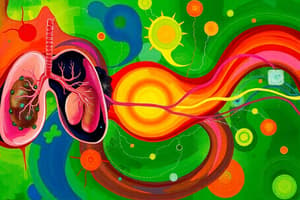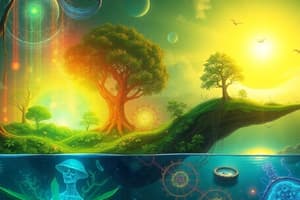Podcast
Questions and Answers
What is the initial step in the Krebs Cycle?
What is the initial step in the Krebs Cycle?
- Formation of a 6-carbon compound
- Conversion of pyruvate into Acetyl-CoA (correct)
- Production of water
- Release of ATPs with water as byproducts
Where does the Electron Transport Chain occur?
Where does the Electron Transport Chain occur?
- Nucleus of the cell
- Inner membrane of the mitochondria (correct)
- Outer membrane of the mitochondria
- Cytoplasm of the cell
What is the main function of ATP synthase in the Electron Transport Chain?
What is the main function of ATP synthase in the Electron Transport Chain?
- Formation of Acetyl-CoA
- Production of ATP (correct)
- Production of water
- Production of NADH
How many ATPs are produced for every molecule of NADH in the Electron Transport Chain?
How many ATPs are produced for every molecule of NADH in the Electron Transport Chain?
What is Acetyl-CoA's role in the Krebs Cycle?
What is Acetyl-CoA's role in the Krebs Cycle?
How many ATPs are produced for every three molecules of FADH2 in the Electron Transport Chain?
How many ATPs are produced for every three molecules of FADH2 in the Electron Transport Chain?
Where does glycolysis take place in the cell?
Where does glycolysis take place in the cell?
What is the main purpose of glycolysis?
What is the main purpose of glycolysis?
Which organelle is responsible for the Krebs Cycle?
Which organelle is responsible for the Krebs Cycle?
What is the end product of glycolysis?
What is the end product of glycolysis?
How many ATP molecules are generated from one glucose molecule during glycolysis?
How many ATP molecules are generated from one glucose molecule during glycolysis?
What happens during Krebs Cycle?
What happens during Krebs Cycle?
Flashcards are hidden until you start studying
Study Notes
Cell Respiration and Photosynthesis
- Cellular respiration is a complex process that releases energy in the form of ATP from food molecules.
Photosynthesis
- No information provided in the text.
Cellular Respiration
- Cellular respiration is a process that converts stored energy in food into chemical energy.
Steps in Cellular Respiration
- Glycolysis: occurs in the cytoplasm of the cell.
- Glycolysis Events:
- One glucose molecule (C6H12O6) is broken down into 2 pyruvate acid molecules, generating 2 net ATPs.
- Phosphate groups from 2 ATP molecules are transferred to glucose molecules.
- The resulting 6-carbon compound is broken down into 2 three-carbon compounds containing phosphate groups.
- 2 NADH molecules are produced, and a phosphate group is transferred to each 3-carbon compound.
- The 3-carbon compounds are converted into 3-carbon pyruvate.
- Glycolysis is a process of harvesting energy by breaking down glucose to pyruvate, producing 2 ATP molecules.
Krebs Cycle
- Occurs in the inner matrix of the mitochondria.
- Krebs Cycle Preparation: 3-carbon pyruvate is converted into 2-carbon molecules called Acetyl-CoA.
- Krebs Cycle Step 1: Acetyl-CoA combines with a 4-carbon compound to form a 6-carbon compound.
- Krebs Cycle: Produces NADH and FADH2.
Electron Transport Chain
- Occurs in the inner membrane of the mitochondria.
- A series of oxidation processes where electrons (in the form of H-) carried by NADH and FADH are transferred to electron receptors.
- Transfer of electrons from coenzymes NADH and FADH to receptors found in the protein complex.
- ATP Synthase: an enzyme that adds phosphate to ADP to produce ATP, producing water as a byproduct.
- Electron Transport Chain Byproducts:
- ATPs are released with water as byproducts.
- 3 ATPs are produced for every molecule of NADH.
- 2 ATPs are produced for every 3 molecules of FADH2.
- 36 ATPs are produced for every molecule of glucose (C6H12O6).
Studying That Suits You
Use AI to generate personalized quizzes and flashcards to suit your learning preferences.




